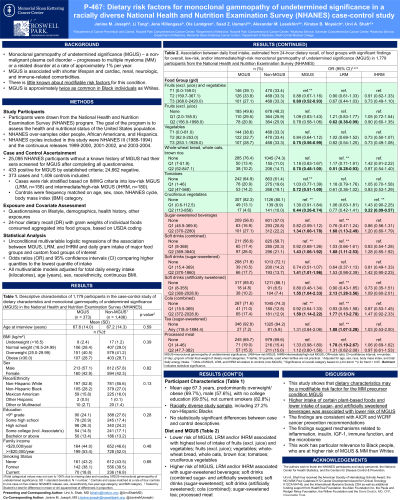QoL and Patient-Reported Outcome and Supportive Care
Poster Session 3
P-467: Dietary risk factors for monoclonal gammopathy of undetermined significance in a racially diverse National Health and Nutrition Examination Survey (NHANES) case-control study
Friday, September 29, 2023
1:15 PM - 2:15 PM EEST

.jpg)
Urvi A. Shah, MD (she/her/hers)
Assistant Attending
Myeloma Service, Memorial Sloan Kettering Cancer Center
New York, New York, United States
Introduction: Monoclonal gammopathy of undetermined significance (MGUS) has a prevalence of 3% over age 50 with a 1% annual risk of progression to multiple myeloma. Although one cohort study in Caucasians from Iceland reported that diets low in whole wheat bread and fruits were associated with MGUS (Thordardottir et al. 2018), research on diet and MGUS in a more diverse population is scarce. Given that diet can vary greatly between ethnic/racial groups, we conducted a population-based study of diet and MGUS in a racially diverse population.
Methods: Using the National Health and Nutrition Examination Survey (NHANES), we conducted a case-control study in 373 individuals with MGUS and 1,406 controls frequency matched on age, body mass index, NHANES cycle, sex, and race. The study sample was diverse, with 27.2% Non-Hispanic Black and 16.0% Mexican American. Diet was characterized by one 24-hour dietary recall, with gram intake of individual foods and beverages aggregated into groups. MGUS status was determined by blood screening. Individuals with MGUS were risk stratified based on Mayo Clinic criteria into low (n=158) and intermediate/high risk (n=180). Unconditional multivariable logistic regressions were used to model associations between intake of several food groups and MGUS and risk stratified MGUS, with odds ratios (OR) and 95% confidence intervals (CI) reported for the highest relative to the lowest quantile of intake.
Results: Daily intake of several food and beverage groups were significantly associated with MGUS, low-risk MGUS (LRM) or intermediate/high-risk MGUS (IHRM). Inverse associations were observed for fruits and vegetables: OR=0.69 (95% CI 0.52-0.93) (MGUS); fruits: OR=0.62 (95% CI 0.38-0.99) (LRM); vegetables: OR=0.75 (95% CI 0.56-0.99) (MGUS); tomatoes: OR=0.72 (95% CI 0.51-1.00) (MGUS); cruciferous vegetables: OR=0.44 (95% CI 0.26-0.74) (MGUS); OR=0.22 (95% CI 0.09-0.57) (IHRM) and whole-grain bread, oats, rice: OR=0.52 (95% CI 0.28-0.95) (LRM). Direct associations were observed for sugar-sweetened beverages: OR=1.34 (95% CI 1.00-1.78) (MGUS); OR=1.68 (95% CI 1.13-2.49) (LRM); sugar-sweetened soft drinks: OR=1.41 (95% CI 1.01-1.96) (MGUS); artificially sweetened soft drinks: OR=1.55 (95% CI 1.04-2.33) (MGUS); OR=2.13 (95% CI 1.28-3.56) (LRM); and cola, combined sugar- and artificially sweetened: OR=1.59 (95% CI 1.14-2.22) (MGUS); OR=1.77 (95% CI 1.13-2.78) (LRM). There were more significant findings for LRM than IHRM, suggesting potential contributing etiologic differences.
Conclusions: Our study shows that low intake of whole grains, fruits, and vegetables and high intake of sweetened beverages are associated with MGUS. The identification of dietary risk factors for MGUS in a diverse population is of direct public health relevance. These findings also provide rationale for exploration of mechanistic links between diet and plasma cell disorders, such as the ongoing studies NCT04920084, NCT05640843, and NCT05312255.
Methods: Using the National Health and Nutrition Examination Survey (NHANES), we conducted a case-control study in 373 individuals with MGUS and 1,406 controls frequency matched on age, body mass index, NHANES cycle, sex, and race. The study sample was diverse, with 27.2% Non-Hispanic Black and 16.0% Mexican American. Diet was characterized by one 24-hour dietary recall, with gram intake of individual foods and beverages aggregated into groups. MGUS status was determined by blood screening. Individuals with MGUS were risk stratified based on Mayo Clinic criteria into low (n=158) and intermediate/high risk (n=180). Unconditional multivariable logistic regressions were used to model associations between intake of several food groups and MGUS and risk stratified MGUS, with odds ratios (OR) and 95% confidence intervals (CI) reported for the highest relative to the lowest quantile of intake.
Results: Daily intake of several food and beverage groups were significantly associated with MGUS, low-risk MGUS (LRM) or intermediate/high-risk MGUS (IHRM). Inverse associations were observed for fruits and vegetables: OR=0.69 (95% CI 0.52-0.93) (MGUS); fruits: OR=0.62 (95% CI 0.38-0.99) (LRM); vegetables: OR=0.75 (95% CI 0.56-0.99) (MGUS); tomatoes: OR=0.72 (95% CI 0.51-1.00) (MGUS); cruciferous vegetables: OR=0.44 (95% CI 0.26-0.74) (MGUS); OR=0.22 (95% CI 0.09-0.57) (IHRM) and whole-grain bread, oats, rice: OR=0.52 (95% CI 0.28-0.95) (LRM). Direct associations were observed for sugar-sweetened beverages: OR=1.34 (95% CI 1.00-1.78) (MGUS); OR=1.68 (95% CI 1.13-2.49) (LRM); sugar-sweetened soft drinks: OR=1.41 (95% CI 1.01-1.96) (MGUS); artificially sweetened soft drinks: OR=1.55 (95% CI 1.04-2.33) (MGUS); OR=2.13 (95% CI 1.28-3.56) (LRM); and cola, combined sugar- and artificially sweetened: OR=1.59 (95% CI 1.14-2.22) (MGUS); OR=1.77 (95% CI 1.13-2.78) (LRM). There were more significant findings for LRM than IHRM, suggesting potential contributing etiologic differences.
Conclusions: Our study shows that low intake of whole grains, fruits, and vegetables and high intake of sweetened beverages are associated with MGUS. The identification of dietary risk factors for MGUS in a diverse population is of direct public health relevance. These findings also provide rationale for exploration of mechanistic links between diet and plasma cell disorders, such as the ongoing studies NCT04920084, NCT05640843, and NCT05312255.
